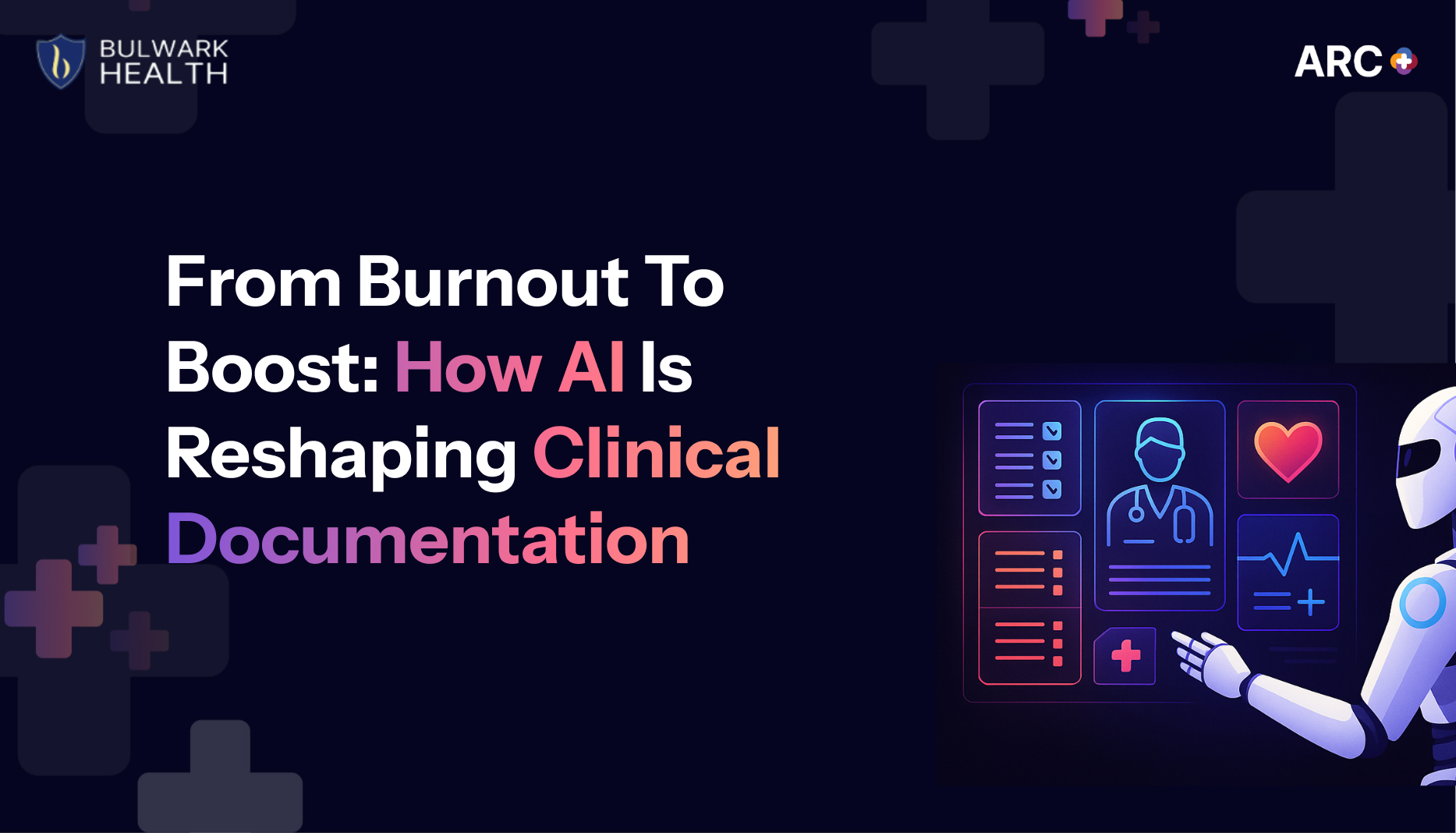Clinical documentation used to be the price of entry to healthcare. Now, it’s the price of burnout.
As per Medium article in 2024, over half of physicians are burned out.
For an industry built on care, clinical documentation has become a barrier, not a bridge.
With physician burnout soaring to a record high, a better system was being called for.
Enter AI.
Clinical documentation is undergoing a massive shift – fueled by AI.
Hospitals are going from reactive compliance to proactive clinical and financial performance.
From fatigue to efficiency. From burnout to boost.
Welcome to our no-fluff, insight-first CDI series.
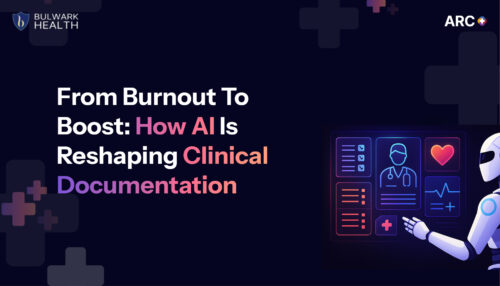
What Is Clinical Documentation?
Clinical documentation is the official record of a patient’s care journey. It captures:
- Symptoms
- Diagnoses
- Procedures
- Progress notes
- Treatment decisions
Whether handwritten or digital, every clinical document must be accurate, timely, and complete.
That’s not just good practice – it’s foundational for billing, compliance, and patient outcomes.
Recommended Read: Why Clinical Documentation Integrity Is a Game Changer
Current Status of CDI (Clinical Documentation Integrity)
CDI has come a long way from just being a coder’s safety net. It’s now a strategic function that impacts:
- Risk-adjusted revenue (HCC, SOI/ROM)
- Quality scores (HEDIS, VBP)
- Compliance (audit readiness, DRG validation)
But traditional CDI still relies heavily on manual chart reviews and sample-based audits, which are time-consuming, labor-intensive, and reactive.
The big question: How do you scale CDI without hiring an army of reviewers?
Role of Generative AI in CDI
Enter generative AI in clinical documentation improvement – the tech behind ChatGPT, DAX, and Bulwark’s ARC+.
Instead of just scanning charts, generative AI can:
- Summarize notes from clinical conversations
- Suggest compliant diagnosis codes
- Flag discrepancies in real time
- Predict DRG shifts or quality risks before billing
So what is clinical documentation improvement in the AI era?
It’s not just about fixing documentation errors. It’s about preventing them in real-time and supporting providers at the point of care.
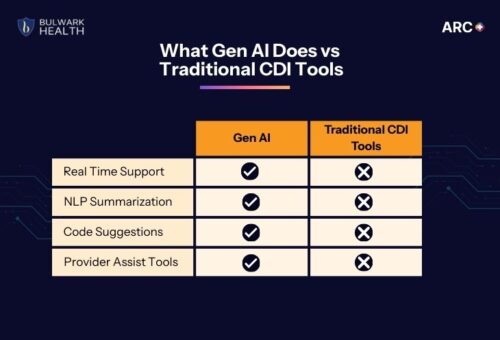
Benefits of Integrating AI into Clinical Documentation
The implementation of AI leads to:
Faster Documentation
AI scribes reduce documentation time by up to 10 minutes per patient, allowing providers to focus on patients instead of paperwork
Higher Accuracy
Large language models (LLMs) help identify documentation gaps, missed diagnoses, or incomplete coding data. This ensures clinicians aren’t just documenting faster, they’re documenting better.
Cleaner Claims
CDI programs using ARC+ have reported up to cleaner claim rates, helping avoid denials, delays, and downstream compliance headaches.
Better Care Quality
By enabling more precise documentation, AI supports stronger clinical communication, more reliable coding, and better performance on quality measures.
Reduced Burnout
AI automation minimizes after-hours charting reducing the “pajama time” clinicians often complain about. That means happier providers, lower turnover, and better morale across the board.
How ARC+ Is Leading the Future of CDI
Unlike legacy CDI tools, ARC+ is built for real-time, AI-powered documentation integrity.
It’s streamlined, AI-enhanced oversight of how documentation flows, gets validated, and turns into revenue and outcomes.
ARC+ doesn’t replace CDI professionals – it supercharges them.
What ARC+ offers:
- Pre-bill audits at scale
- Smart chart prioritization (e.g., DRG, HCC, SOI impact)
- 100+ compliant query templates
- Dashboards for CDI, provider, and quality tracking
- Inpatient and outpatient CDI support
Book a demo today to know how ARC+ can benefit your team.
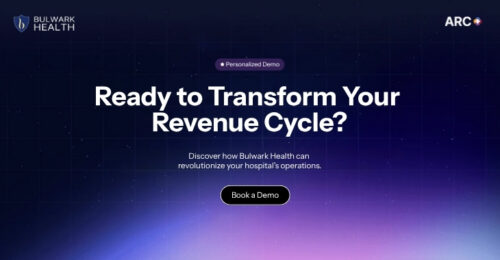
Challenges and Future Trends in Clinical Documentation
AI has reshaped clinical documentation workflows, but like any innovation, it comes with real-world hurdles and the promise of smarter, more personalized systems ahead.
Current Challenges
- AI-generated hallucinations or inaccuracies
- EHR integration complexity
- Clinician skepticism or tech fatigue
- Regulatory uncertainty on AI use in documentation
Future Trends
- On-device AI: With privacy becoming critical, expect models that process data securely on local hardware.
- Physician-customizable AI note templates: Personalization will become standard, reducing friction and improving adoption.
- Ambient voice-driven documentation: Passive, real-time capture of clinical conversations will become mainstream.
- AI as a compliance co-pilot: Think of AI not just as a documentation tool, but as a real-time guide for ensuring quality and coding accuracy.
The road ahead is exciting but demands thoughtful design, clear guardrails, and deep collaboration between health systems and tech innovators.
FAQs
Who are users of clinical documentation?
The users of clinical documentation are:
- Physicians and nurses
- Coders and billers
- CDI and quality teams
- Payers
- Auditors and regulators
How does clinical documentation affect patient care?
Good documentation = better handoffs, accurate diagnoses, safer treatments.
What is the most important use of clinical documentation?
Telling the patient’s story truthfully – so care, billing, and compliance follow suit.
Conclusion
Clinical documentation is no longer just a backend function. It’s the lifeblood of modern care; and AI is pumping new energy into it.
From reducing burnout to boosting revenue and outcomes, the shift is real, and it’s already underway.
Hospitals that embrace this change will not only survive – they’ll lead.
If you are not already using AI in your workflows, or want to upgrade your systems, book a demo with Bulwark today.







